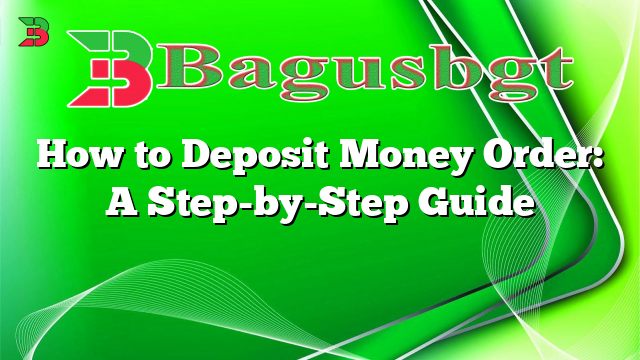Hello and welcome to our comprehensive guide on how to deposit a money order. In this article, we will walk you through the process of depositing a money order, step by step, to ensure a smooth and hassle-free transaction. Whether you’re new to money orders or just need a refresher, this guide will provide you with all the information you need to know.
1. Understanding Money Orders
Before we dive into the process of depositing a money order, let’s first understand what exactly a money order is. A money order is a prepaid payment method, similar to a check, that can be used to send or receive money securely. It is often preferred by individuals who do not have a checking account or want to ensure a guaranteed payment.
2. Gather the Required Documents
Before heading to the bank or financial institution to deposit your money order, make sure you have the necessary documents. You will typically need the original money order and a valid form of identification, such as a driver’s license or passport.
3. Endorse the Money Order
Prior to depositing the money order, you must endorse it on the back. Flip the money order over and sign your name in the designated endorsement area. Make sure to follow any specific instructions provided on the money order itself.
4. Choose a Deposit Method
Next, decide how you would like to deposit the money order. You have two main options: depositing it in person at a bank or financial institution, or depositing it electronically through a mobile banking app. Choose the method that is most convenient for you.
5. Depositing in Person
If you choose to deposit the money order in person, visit your preferred bank or financial institution. Fill out a deposit slip with the necessary information, including your account number and the amount of the money order. Submit the deposit slip and money order to the teller.
6. Depositing Electronically
If you opt for electronic deposit, open your bank’s mobile banking app. Select the option to deposit a check or money order and follow the on-screen instructions. Take clear photos of the front and back of the money order and submit them through the app. Make sure to double-check the deposit amount before finalizing the transaction.
7. Wait for Verification
Once you have completed the deposit, whether in person or electronically, the bank or financial institution will verify the money order. This process typically takes a few business days. It is essential to keep the money order and any associated receipts until the verification is complete.
8. Check Your Account
After the verification process, check your bank account to ensure that the funds from the money order have been successfully deposited. If there are any issues or discrepancies, contact your bank or financial institution immediately for assistance.
9. Keep Documentation
It is crucial to retain all documentation related to the money order deposit. This includes the original money order, any receipts or transaction records, and any communication with the bank or financial institution regarding the deposit. These documents will serve as proof of the transaction in case of any future disputes.
10. Alternatives to Money Orders
While money orders are a reliable and secure form of payment, there are alternatives available. Some popular alternatives include online payment platforms, such as PayPal or Venmo, and electronic bank transfers. These methods offer convenience and speed, making them attractive options for many individuals.
| Question | Answer |
|---|---|
| Can I deposit a money order into someone else’s bank account? | Yes, it is possible to deposit a money order into someone else’s bank account. However, they may require you to provide additional documentation and authorization. |
| What happens if I lose my money order? | If you lose your money order, you should contact the issuer immediately. They will guide you through the process of obtaining a replacement or refund. |
| Is there a maximum limit on money orders? | Yes, most money orders have a maximum limit, typically around $1,000. If you need to send a larger amount, you may need to purchase multiple money orders. |
| Can I deposit a damaged money order? | In most cases, banks and financial institutions will not accept damaged money orders. It is best to contact the issuer and request a replacement. |
In Conclusion
Depositing a money order is a straightforward process that requires proper documentation and following the necessary steps. By understanding the process and choosing the most convenient deposit method for you, you can ensure a successful transaction. Remember to keep all documentation and contact your bank or financial institution for any issues or concerns. Consider the alternatives to money orders if you are looking for faster and more convenient payment options. Now that you are equipped with the knowledge on how to deposit a money order, you can confidently handle your financial transactions.
 Bagus Banget Collection of the latest information from various reliable sources
Bagus Banget Collection of the latest information from various reliable sources





